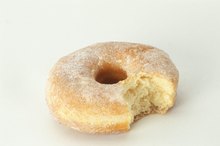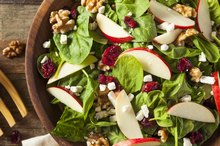What does fact checked mean?
At Healthfully, we strive to deliver objective content that is accurate and up-to-date. Our team periodically reviews articles in order to ensure content quality. The sources cited below consist of evidence from peer-reviewed journals, prominent medical organizations, academic associations, and government data.
The information contained on this site is for informational purposes only, and should not be used as a substitute for the advice of a professional health care provider. Please check with the appropriate physician regarding health questions and concerns. Although we strive to deliver accurate and up-to-date information, no guarantee to that effect is made.
What Is the Doug Kaufmann Phase One Diet?
Doug Kaufmann is an author and host of a televised health talk show available through cable and satellite 1. Upon returning from the Vietnam war in 1971, Kaufmann experienced fatigue and other health problems of unknown origin, according to his bio. Kaufmann claims that he discovered changing his diet and eliminating sugar relieved his health problems and used this as a basis for creating the Phase One diet 1.
Anti-Fungal Diet
The Phase One diet is based on a controversial theory that the typical diet, which is high in sugar, promotes fungal overgrowth in the body. Currently, evidence to support this theory is lacking. The goal of the Phase One diet is to eliminate foods high in sugar, particularly added sugar and what Kaufmann considers "fungal" foods, according to his book "The Fungus Link" published in 2001 1. Kaufmann claims doing so will improve your health.
- The Phase One diet is based on a controversial theory that the typical diet, which is high in sugar, promotes fungal overgrowth in the body.
Phase One
Phase One of the Anti-Fungal Diet
Learn More
The goal of the Phase One diet is to minimize sugar intake because it feeds fungi, says Kaufmann. Phase one lasts approximately 30 days and is designed to starve fungus. Dieters following the Phase One diet cut out all added sugar and use stevia and other alternative sweeteners.
Beyond Phase One
After phase one of the Phase One plan, dieters begin reintroducing some otherwise healthy foods such as mushrooms, high-sugar fruits and starchy vegetables, in what's called "phase two.'' Kaufmann advises that if a dieter's symptoms return after reintroducing high-sugar food, it might be necessary to keep it to a minimum as a permanent lifestyle change. Kaufmann recommends keeping added sugar to a minimum as a permanent change in what he calls the "lifetime phase." The American Heart Association recommends limiting added sugar to no more than 100 and 150 calories per day for women and men, which equals 6 and 9 teaspoons respectively 12.
- After phase one of the Phase One plan, dieters begin reintroducing some otherwise healthy foods such as mushrooms, high-sugar fruits and starchy vegetables, in what's called "phase two.''
- Kaufmann advises that if a dieter's symptoms return after reintroducing high-sugar food, it might be necessary to keep it to a minimum as a permanent lifestyle change.
The Verdict
Recurrent Yeast Infections and Eating Too Much Sugar
Learn More
While Kaufmann is hardly the first person to create a diet based on the "fungal" theory, there's no evidence to suggest your body is overrun by fungus due to a sugary diet 1. That being said, it is beneficial to decrease your consumption of added sugars. Cutting back on these can benefit your health since excess sugar supplies extra calories, no nutrients and can contribute to weight gain and other health issues.
Related Articles
References
- The Fungus Link; Doug A Kaufmann
- American Heart Association: Sugar 101
Writer Bio
Janet Renee is a clinical dietitian with a special interest in weight management, sports dietetics, medical nutrition therapy and diet trends. She earned her Master of Science in nutrition from the University of Chicago and has contributed to health and wellness magazines, including Prevention, Self, Shape and Cooking Light.









